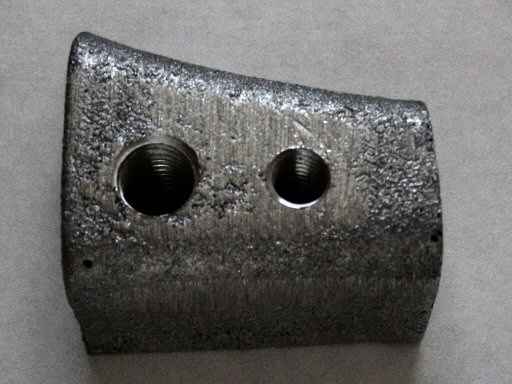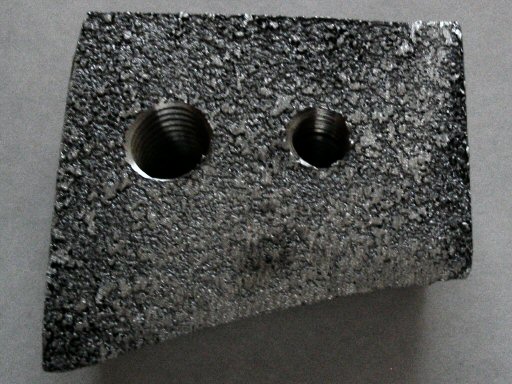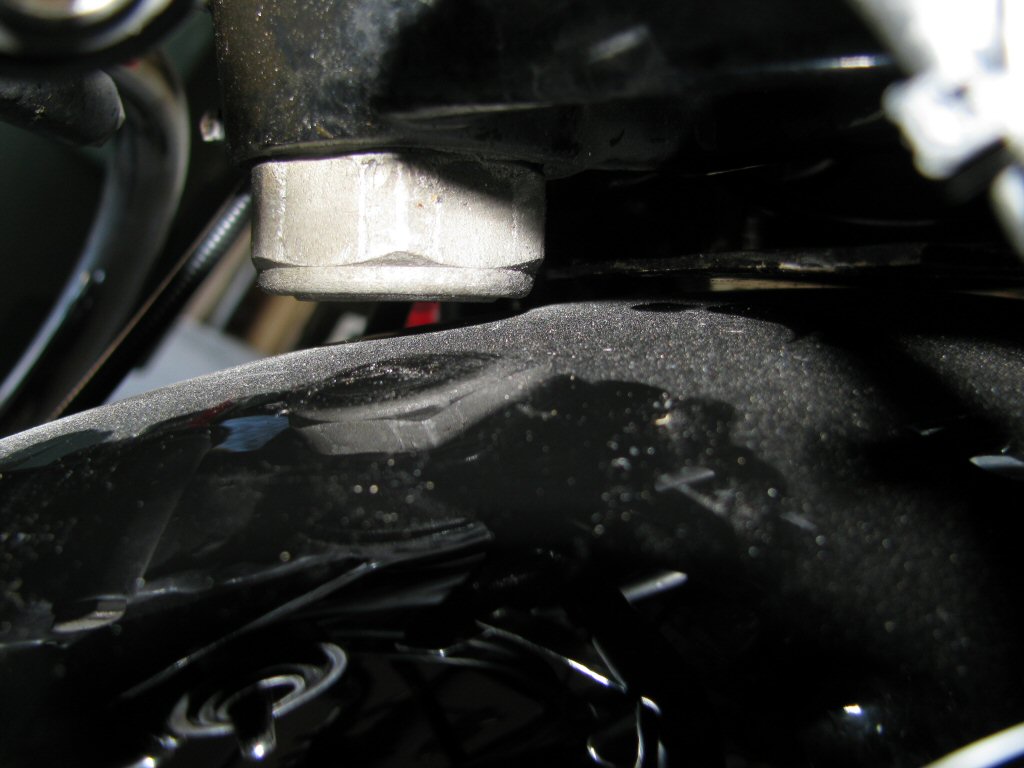Steering dampers, aluminum spacer blocks, fork travel, and fender dents
Moto Guzzi V700, V7 Special, Ambassador, 850 GT, 850 GT California, Eldorado, and 850 California Police models
Updated:
Aluminum spacer block for mounting a steering damper
I met Kim Schick at the 2006 Moto Guzzi National Owners Club (MGNOC) national rally in Elkader, Iowa. We got to talking about steering dampers and I learned that Kim had cast a number of the special aluminum blocks (or lugs
, as Moto Guzzi calls them) for mounting the steering damper to the underside of the triple tree. First class work and Kim hooked me up with one (Thanks!).

Photo courtesy of Gregory Bender.

Photo courtesy of Gregory Bender.
Fender dents
After examining numerous loops using the stock steering damper set up, Kim and I found that most (all?) had some sort of fender dent from the head of the bolt contacting the top of the fender on full fork spring compression. It seems that even the stock configuration did not fully account for the issue of full spring compression. After further investigation, Kim found that the pocket recess in the lower triple tree for the aluminum spacer block is different between different models. Specifically, he found the following differences:
- MG# 12494200 Early V700 (found in first edition spare parts catalog only): Aluminum block is flush with the triple tree.
- MG# 12494201 Later V700, All Ambassador and All Eldorado (found in all other spare parts catalogs I have): Aluminum block is flush with the triple tree.
- MG# 12494070 Side car triple tree: Aluminum block protrudes from triple tree ~1⁄8 inch.
Fork travel
After further contemplation, I decided to calculate the minimum space needed between the bottom of the lower triple tree and the top of the fender (thanks to Paul Linn for taking the time to measure the maximum fork travel on a set of uninstalled drum brake forks he had). Here is the math and logic I used...
- Total tube travel within each fork leg is 121 mm (~4.75 inch)
- Part - but not all - of that total travel is taken up by the spring. The stock spring wire diameter is 5.76 mm and has 16 turns. When fully compressed, the spring would take up 92.16 mm of space (5.76 mm * 16 = 92.16 mm)...or roughly 3.628 inch. The Wirth progressively wound replacement spring has a wire diameter of 5.8 mm and approximately 15 turns, yielding 87 mm when fully compressed. Given that the spring can compress more than the total available travel, the spring will
- never completely compress or bottom out
- will never - in and of itself - prevent the fender from hitting the anything connected to the bottom of the lower triple tree
- Available free space:
- With the stock spring, that leaves 28.84 mm of available free space.
- With my Wirth springs, that leaves 34 mm of available free space.
What limits fork travel?
I had my front fender dent repaired and the fender repainted. Before installation, I decided to make absolutely certain that I had sufficient space for my steering damper. There is no joy in re-denting the fender in exactly the same place immediately after it has been fixed!
Knowing that the fork springs do not take up all the available free travel of the fork legs, I removed the fork springs and then reinstalled the forks. When I compressed the forks completely (easy to do with the springs removed), I discovered that the fender could come in contact with not only my steering damper, but also with the bottom of the triple tree.

Photo courtesy of Gregory Bender.
I had always assumed that the fork tube would bottom out before the fender would come into contact with anything. Not so. The original factory design permits the fender to slam directly into the bottom of the lower triple tree - unimpeded save for the pressure exerted by the fork springs. To say that I am not impressed with this design is a gross understatement.
I decided to figure out how long of a spacer would be required to provide sufficient clearance for the front fender upon full spring compression. I cut spacer tubes (1 1⁄2 inch PVC pipe works very well for this) of various lengths and installed them one at a time and checked for sufficient clearance. Once again, this was done without any fork spring installed so that I could easily compress the fork tubes to determine clearance.
- I started with a spacer tube 87 mm long, as this is the fully compressed length of my Wirth fork springs. The fender could still hit the underside of the lower triple tree.
- I cut a spacer tube 93 mm long, as this is the fully compressed length of the stock fork springs. The fender could still hit the underside of the lower triple tree.
- I cut a spacer tube 100 mm long. The fender could still hit the underside of the lower triple tree.
- I jumped up a bit and cut a spacer tube 130 mm long. Finally, the fender had plenty of clearance.
- I cut a spacer tube 110 mm long. The fender still had clearance.
- I cut a spacer tube 103 mm long and found my limit. The fender had barely enough clearance.
I decided I would try cutting a preload spacer of sufficient length that when combined with a fully compressed fork spring, there would be no chance of fender dents. I know, I am playing around with binding the fork spring coils and that is a bad thing to do. But, I at least wanted to see if it were possible to do so. Subtracting 87 mm (length of my fully compressed Wirth fork springs) from 103 mm (my measured limit using the 1 1⁄2 inch PVC spacer tube) gives me 16 mm. So, I cut a pair of preload spacers 16 mm long and attempted to install them on top of the existing springs. 16 mm is a whole lot longer that it sounds and using them was going to preload my Wirth springs way too much. So, I didn't install them.
In the end, I reinstalled my Wirth fork springs without any preload spacer at all. I've always liked how these springs have functioned and changing the preload would change performance, not what I wanted. Plus, I've never had trouble with the fender hitting the bottom of the triple tree...though I now know that it is certainly possible for that to happen.
The bottom line
The key point from all this math and logic and testing is that there needs to be a minimum of 121 mm (~4.75 inch) between the bottom of the triple tree and the top of the corresponding point on the fender. If there isn't, then there is a very real risk of denting the front fender.
It is easy to check your machine. Jack up the front end so that the front wheel is off the ground. This extends the front fork completely. Then, just measure between the triple tree and the fender.
There are steps that must be taken any time a steering damper is added in order to avoid dents in the top of your fender. Here are a few suggestions:
- THE WRONG WAY: Install a preload spacer on top of each spring that takes up more than the maximum available free space. Doing so will limit total travel. The downside is that there is a very real chance of the spring completely collapsing and binding. THIS IS BAD. DON'T DO IT.
- Modify the steering damper mount/bolt so that you have a minimum of 121 mm (~4.75 inch) of space between it and the top of the fender. Here are some ideas...
- If you are using the stock aluminum spacer block and it protrudes below the pocket in the triple tree, file off the protruding portion to get the steering damper as snug to the triple tree as possible.
- Use a bolt with a low profile head to secure the steering damper to the aluminum block. Perhaps a button head bolt would work well.